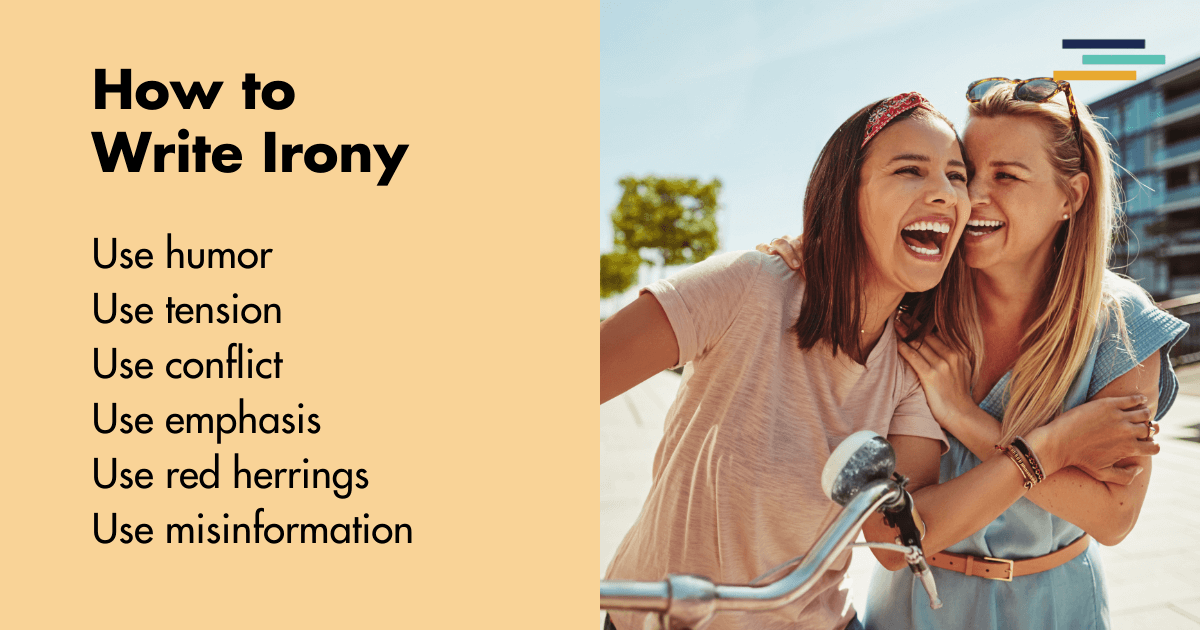
“Irony is just honesty with the volume cranked up.”—George Saunders
What is Irony?
Irony is when the opposite of the expected happens. Examples range from simple jokes to elaborate and convoluted plot lines. Some simple examples include:
- A professional bodybuilder named Tiny
- A timid person called Hercules
- A person who makes themselves sick by worrying about their health too much
- Describing concrete as being as solid as gelatin
- Describing a pillow as feeling as soft as marble
Irony Examples
Well-known examples from literature show how irony can be employed in ways that can be funny or heart-breaking. Here are two cases from the plays of Shakespeare:
Funny Irony
In the comedy A Midsummer Night’s Dream, the fairy queen Tatiana is enchanted by a love potion and becomes infatuated with an actor comically transformed to look like a donkey. Oblivious to this, she extravagantly praises his handsome appearance and describes his donkey braying as sweet music.
Heart-Breaking Irony
In the tragedy Romeo and Juliet, Romeo finds his beloved Juliet presumably dead in her tomb, and kills himself out of grief. Juliet then wakes and, also overcome with sorrow, joins her new husband in death.
Neither Romeo nor Juliet wanted to live without the other, and yet the irony is that everything they do to come closer together despite their circumstances only pushes their families, and themselves, further apart.
The Purpose of Irony
Irony can intentionally create a gap between what a character says or does, and what is understood by the reader and other characters. This gap can also result when different points of view between characters cause something unlikely or surprising to happen.
If one character is describing a race horse as having strong legs, a graceful stance, and checkered racing colors, and another character is looking at the horse’s jockey, they might agree when comparing those three points that both man and horse have in common. The irony of the situation will come to the fore when the first character mentions the muzzle or the hooves.
The flexibility of irony as a literary device in a story allows the writer to add extra layers of meaning. When a reader recognizes a contradiction or discrepancy, proving that circumstances are not what they appear to be, this is often seen as humorous. At other times, the disconnect can be seen as disturbing, eye-opening, or even tragic.

The History of Irony
In ancient Greece, comedic playwrights would include a stock character called an “eiron” who would deliberately downplay his own abilities and thus trick his opponent into underestimating his chance of winning a fight. Using witty wordplay, the eiron would overcome his egotistical opponent by saying one thing but meaning another.
Our word irony comes from the Latin version of this concept, “ironia,” meaning “feigned ignorance.” Irony was used by ancient Greek and Roman playwrights where expectations were defied and conventions were turned on their heads.
In a similar way, modern storytellers also find irony a powerful tool for engaging their readers. Irony is a much-used literary technique that makes use of a contradiction between appearance and reality and highlights the significance of perception versus facts.
The resulting effect on readers can be funny and lighthearted or profound and uplifting, making irony a versatile tool for writers.
What Are The Three Kinds of Irony?
There are three primary types of irony: verbal irony, dramatic irony, and situational irony.
Verbal Irony
In verbal irony, a character will say one thing when they mean something else. The intended meaning of a spoken word or phrase is knowingly given an unintended interpretation, and this difference between expectation and the truth is the basis for verbal irony. The contrast can be stark or subtle. In this kind of irony, one or more of the characters provide the reader with clues, so the reader is let in on the ironic action.
Sarcasm is a subtype of verbal irony. Sarcasm is typically stated directly and is harsh or mocking. Verbal irony is more often strange or funny and is indirectly implied.
Dramatic Irony
In dramatic irony, the reader knows critical information that the characters do not. Thus the characters are expecting one outcome from a situation when the reader knows the truth is the polar opposite of what the characters believe.
In this kind of irony, the reader understands the ironic incongruity in the story before any of the characters catch on.
Situational Irony
Situational irony occurs when events go awry and run counter to expectations so that characters’ intentions do not coincide with the planned outcome.
Situational irony undermines typical cause-and-effect relationships and causes situations that cannot be explained logically. This can lead to readers viewing situational irony as humorous. In other circumstances, where misfortune or heartbreak results, readers will be left with a sense of tragedy.
With the unpredictable results from situational irony, the readers find out about the contrast between assumptions and reality at the same time as the characters.
Examples of the Types of Irony in Literature
Examples of verbal irony range from simple analogies such as “clear as mud,” “cuddly as a cactus,” and “no good deed goes unpunished,” to elaborate protracted metaphors such as in Shakespeare’s Sonnet 130 (My Mistress’ Eyes are Nothing Like the Sun) where exaggerated sentiments are interpreted unexpectedly, taken literally instead of figuratively.
Dramatic Irony Example
Dramatic irony, where the reader knows something the characters do not, happens often in historical fiction and alternate-history novels.
The reader knows what will happen in a story set in 1815 when Napoleon tries to invade a little place called Waterloo, or that a story set in 1989 will include dramatic changes in lifestyles after Tim Berners-Lee sets up his World Wide Web. Horror and thriller genres often hinge on the mounting tension created when the reader knows the hero is walking straight into a trap.
Situational Irony Example
Situational irony, where a character assumes their action will lead to a desired outcome but then finds themselves flummoxed by an unintended result, is a staple of contemporary sitcom episodes.
Situational comedy is awash in characters surprised by unexpected situations and floundering to recover, sometimes trying to pretend nothing is amiss.
An example can be seen in the second book of the Bridgerton series by Julia Quinn. Kate secretly sacrifices everything to give her sister Edwina a chance at a fairy tale marriage, but keeping these secrets is the very thing that leads Edwina to refuse an advantageous proposal.

How to Write the Different Types of Irony
In the writer’s toolbox, irony can be a useful and versatile technique. Irony can convey a hidden meaning or subtext to the plot. It can criticize and poke fun at what characters say and what ideals they profess.
Let’s look at the various applications of irony in fiction, as well as how we can use Fictionary to keep track of their effect.
Using Humor in Irony
Pointing out inconsistencies or false impressions arising from an ironic statement or situation is inherently funny. Laughter is a common response when something unexpected or surprising happens.
Keeping count of how many times the protagonist laughs or at least smiles throughout your story is a good indication of how light-hearted a character will appear to a reader.
In Fictionary, the Impact on POV Character story element is a great place to tally up these moments. For laughter, the Sounds element is another good choice.
Using Tension in Irony
When the reader expects something predictable to happen but instead something else actually happens, irony can add tension to a scene. Will the unexpected cause something bad to happen?
Tension is also bolstered when dramatic irony spotlights a knowledge gap. The Tension story element in Fictionary’s software is the place to keep track of these.
Using Conflict in Irony
In addition to tension, ironic interpretations of words and actions can ignite conflict between characters. Each might hold the other responsible for an unfortunate development.
Whether they come to blows or just give each other the silent treatment, the story element of Conflict can identify these story moments.
Using Emphasis in Irony
Irony is a memorable way to draw attention to a plot point, paint a vivid character portrait, or insert a plot twist.
To make it easier to find these moments while editing or revising, Fictionary’s Purpose element allows for adding specifics about scenes where “the opposite happened.” The progression of a character trait or character growth through a story can be documented in the POV Goal Internal element or the Impact on the POV Character element.
Using Misinformation/Red Herrings in Irony
Irony can be used to great effect in crafting to misdirect a character or the reader, distracting them so they do not immediately detect an upcoming surprise in the plot.
The Revelation element or the Impact on POV/Protagonist elements can serve to keep track of who knows what and when they find out in your story.
Types of Irony Conclusion
Irony is a versatile tool. It allows the writer to impart subtleties about characters and plot, conveying knowledge to the reader by exploiting the gap between the way things appear and how they are in actuality.
All three kinds of irony provide additional layers of meaning to the reader, whether through verbal repartee, an ambiguous situation, or a character being unaware of the fate ahead of them.
For a writer, exploring the possibilities arising from unanticipated results in a story through misunderstood or misinterpreted words, situations, or events, are what make irony such a potent technique for engaging readers.


